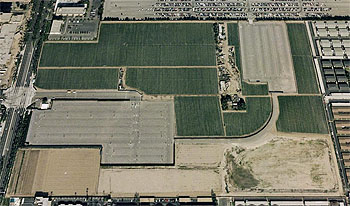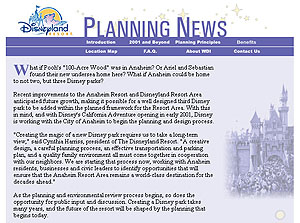– Excerpt from thirdthemepark.com
Yes, what about that, Mr. Eisner?
With all the fooferall surrounding recent rumors of a fifth gate (or 4th and a half gate) in Florida, I’ve been reminded of an odd period in Disney history when, from 2000 until 2002, Disney operated a website called thirdthemepark.com. Occasionally when I make joking reference to the site as a generic verbal stand-in for any gross instance of managerial hubris, I find that Disney fans don’t remember or were not aware that this page once existed.
Thirdthemepark.com is a fairly interesting piece of Disney theme park lore, especially for those interested in the NeverWorld of lost park concepts. While the site itself is long gone (its URL is currently owned by an individual in Colorado), one can still view elements of it courtesy of the Internet Archive. So lets travel back, forty thousand years (or, say, seventeen), and take a look at this mysterious website and the process leading up to its creation.
 Nothing is real.
Nothing is real.The story begins, as all good stories do, with a Japanese immigrant farmer and his family’s strawberry fields. Hiroshi Fujishige’s father arrived in America in 1915 and settled down outside of Los Angeles, where he began to farm and eventually married in 1918. The Fujishiges lived there until 1941, raising Hiroshi and his brother Masao, until the outbreak of World War II led to a number of U.S. policies unfriendly to Japanese-Americans. Seeking to avoid the internment camps, Hiroshi’s family agreed to a government-directed “voluntary evacuation” and moved to live with a relative in Utah.
Hiroshi, who had just left high school after the completion of his third year, was eventually drafted into the army. Before he departed for Europe, however, he became violently ill with an infection only to discover that he had been poisoned by a dentist who sought revenge for a relative lost in the Pacific War. By the time Fujishige had recovered, the war was over.
At this point Hiroshi and his brother moved back to California and started a farm in Norwalk. Several years later, in 1953, they traded that land for 58 acres in Anaheim. The deal, worth about $2,500, allowed them to farm in peace without being hemmed in by development. Then, two years later, Disneyland opened and rural Anaheim changed forever.
Forty years later, Fujishige was still waking to at 5 a.m. every day to tend to his strawberries on the farm he owned with his wife of thirty years. He operated the fruit and vegetable stand from 7 a.m. to 5 p.m. daily, while raising his crops on land valued between $1 million and $2 million an acre. In 1994 he told the Washington Post, “if I had more schooling and knew what all these deals were, I might have been out of here a long time ago” and called himself “just a dirt farmer”. Yet while Fujishige affected a folksy hayseed persona, he was obviously a shrewd customer who knew exactly how valuable his farm was worth. It was this refusal to be bullied or bought that drove developers, and Disney management, crazy for decades.
Fujishige had already refused many offers, some upwards of $50 million, by the 1980s. In 1985 he was taken to court by the city of Anaheim who sought in vain to build access roads for new development through his property. After an arsonist burned down the fruit stand in 1986, the Fujishige family agreed to the project but the development eventually fell through. That same year Masao Fujishige killed himself, allegedly due to despair stemming from his slow recovery from a stroke. And then, into this mix of despair and determination, with his mind solely fixed on resort expansion, strolled Michael Eisner.









[…] themes. We’ve already touched upon the story of Disney’s America, as well as the process that led WESTCOT to be downsized and eventually cancelled. Port Disney followed a similar path to […]
Fascinating article, its really a shame what the management did to Disneyland and Disney World in the ’90s, even today.
As of right now it seems the third gate is going to be a parking lot until at least 2017-2018. We can keep our fingers crossed for what it will become after that but they have lots of issues to fix in their existing parks before building a third or fifth gate.
Thanks… it’s true, we’re still paying the price for those policies.
I’ve been so busy lately I haven’t had a chance to cover the parking lot news. Looks like Third Theme Park is a ways away, and that’s probably a good thing. DCA is no Westcot, and needs many years of attention. Disneyland, too, needs some love and a new Tomorrowland!
Another fantastic article. I am constantly captivated by the wonderful information you present and much appreciate (and in most instances agree) with your commentary about the state of Disney theme parks, its successes, failures, and changes that need to be made.
I hate to take the discussion into the realm of backseat imagineering, but I hope the powers at be, as penance for DCA, really work to conceive a wholly original and inspired third gate for DLR. I cannot help but have a kernel of hope for DCA given the flavor of improvements they are applying to the park, specifically Buena Vista Street and the (albeit superficial) re-themed Silly Symphony Swings. DCA could be very successful as “Walt Disney’s California Adventure,” a park dedicated to the California young Walt experienced, the one that inspired and informed his work, and what came of it in his early years. I think this sort of philosophy, a sort of back-to-the-beginning investigation of Disney history and appreciation for classics, should really be at the heart of Disneyland development. Let Disney World be innovative. Let DLR be that little bit of the past Walt hoped no one would ever truly let go of.
In that vein, I wouldn’t want to see a revival of Disney’s America or Port Disney. I wouldn’t even want to see WestCOT, as impressive as the concept was, just because it draws so heavily from Epcot (and I’m sure we will never see the concept of a city ever again). DCA’s Hollywoodland has, thankfully, saved us from another studios park, and the plot of land couldn’t accommodate something akin to Animal Kingdom. As I child, when I first saw the Silly Symphony short “Music Land,” I thought that would be an amazing theme for a park, with Disney shorts and Silly Symphonies as the themes for lands and attractions, though I am unsure now if an entire park could be built with that theme. Nonetheless, this is the sort of development Disneyland deserves, and I hope management realizes this, too.